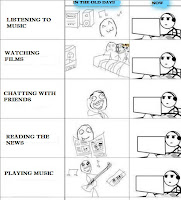In class today we were given a SMART Board presentation by Anne Forrest called 'Context Creation Seminar.
What is a SMART Board?
The SMART Board interactive teaching system is a hand-touch screen connected to a personal computer or laptop and a digital projector. Both front- and rear-projector models are available. Teachers can display information from their computers onto a screen, usually a 77-inch screen. Instead of writing lessons on the board, educators can simply type them into their computers, at school or at home and display them onto the SMART Board. And, rather than being called up to the chalkboard, kids enjoy being called on the use the touch screen.
Read more: Information on SMART Boards | eHow.com http://www.ehow.com/about_5087930_information-smart-boards.html#ixzz1k4C5U6CZ
Anne introduced the class to SMART Board technology, giving us step by step instructions and advice about how to use SMART boards effectively in the classroom. Information was given about how to access and utilise specific smart board softwear to enhance lessons - making them more engaging, interactive and educationally stimulating for the pupils.
Instructions were given regarding pull tabs; object animation; areas to reveal;move and reveal; colour reveal; magnifying glass; tables; linking pages and adding sound.
I feel that the lesson content was excellent - the information given was extremely useful and showed how the smart board can enhance lessons by providing a wide range of resources; diverse and interactive activities and challenging but enjoyable learning opportunities.
one of the key features of effective teaching is the use of a diversity of approaches that enables the teacher to elicit and sustain pupils' interest and involvement in their learning. (Kyriacou,2009,p.3.)
On a personal note I struggled to keep up as the presentation was pitched above a beginners level. Because I was taking notes throughout the lesson and observing instructions being delivered on the main smart board I struggled to complete every task. I intend to take some time over the next few weeks to explore and practice using the smart board in the ICT suite at my own pace. During 1SE1 placement the classroom had a smart board that was not used due to teacher inexperience of the softwear. In 2SE1 the class,again,had a smart board but it was used as a chalk board - just for writing on.
After observing just how much a smart board can do I am determined to develop my experience and confidence is using them to their full potential in the classroom.
References
Kyriacou.C.(2009) Effective Teaching in School. Third Edition. Nelson Thornes;Cheltenham.
http://www.ehow.com/about_5087930_information-smart-boards.html#ixzz1k4C5U6CZ
Friday, 20 January 2012
Social Media and Communities of Practice 160112
SOCIAL MEDIA AND COMMUNITIES OF PRACTICE
Today we looked at Social Media and how it has developed and changed during the 21st Century. We considered how some of the technology we use now has evolved and how this impacts on the way we work,socialise and communicate with each other.
I feel that the social world is becoming smaller and smaller. Yet paradoxically, advances in technology are connecting people together in an isolating way.In this respect the next generation seems to be leading the way.
Both socially and psychologically, the 'digital generation' is seen to operate in quite different ways from the generations that preceeded it.
(Buckingham,2008,p.75.)
Technology like iphones, tablets and kindles are impinging on how we spend quality time together. Is texting replacing talking? Is facebook replacing face to face? It is clear that - as with social change - technology is also changing how the next generation is being educated.
Having digital technology at their fingertips all the time means that students think, work, and play differently from previous generations.
(Solomon and Schrum, 2007.p.27)
According to one 2009 study, an average of 2,272 text messages a month are currently sent or received via a US teen's phone screen; a 2010 report found that text massaging and social networking accounts for 64 percent of all cellphone use amoung 16-24 year olds in the UK.
(Watson,2010, p.11.)
When considering how people interact in today's technological society it is appropriate to analyse what Etienne Wenger describes as 'Communities of Practice.'
Communities of practice are groups of people who share a concern, a set of problems, or a passion about a topic, and who deepen their knowledge and expertise in this area by interacting on an ongoing basis.
(Wenger et al cited Donelan,2010,p.176.)
Wenger states that there are three main characteristics to a community of practice -
The Domain - People working together have a shared domain of interests. The group is able to value and learn from each others collaborative expertise.
The Community - The group work collaboratively and share information with each other that is in the best interests of the domain.
The Practice - the physical act of undertaking a 'shared interest' task. Important becauce the community members are brought together in a kalidescope of expertise.
(Johnson and Johnson. 1999.no page)
Meredith Belbin's Theory about Team Roles states that we all have a particular role that we play in each group. The effectiveness of the group depends on how the differing partise skills are merged collaboratively for the good of the shared interest.
I believe that throughout my employment history and also in University I tend to take the 'shaper' role in any group activity. Although I have a strong voice in a group I am also interested in supporting other members to push their expertise forward and mould the groups objective around our collaborative expertise.
As trainee teachers the classroom environment provides many challenges relating to group dynamics,communication and the role of each pupil. Social media is having a major impact on this.
It is my view that the way people communicate has changed forever. I agree with Wenger's definition of how a group of people work together for a common goal but if you were to ask 'How' this is achieved 20 years ago compared to now the answers would be completely different. In my lifetime e-mail is replacing letters; text is replacing phonecall; conference calls are replacing meetings.
I have grown up living in the 'Digital Immigrants' camp, although I am in the process of morphing into a 'Digital Native'. As I develop my understanding of new technology and how it can enhance classroom teaching and learning I can't help but remennise about a simpler time. This elective is my chance to catch up with today's technological society.
Referencing
Buckingham,D. (2008). Beyond Technology:Children's learning in the age of digital culture. Cambridge:Polity Press.
Donelan,H.,Kear,K.and Ramage,M.(2010). Online Communication and Collaboration. Oxon:Routledge.
Johnson,D.Johnson,R.(1999) Learning Together and Alone. Massachusetts:Viacom Company.
Solomon,G. Schrum,L.(2007)Web 2.0 new tools,new schools. 1st Edition. Washington:International Society for technology in Education (ISTE).
Watson,R.(2010). Future Minds:How the digital age is changing our minds,why his matters and what we can do about it. UK: Nicholas Brealey Publishing.
Today we looked at Social Media and how it has developed and changed during the 21st Century. We considered how some of the technology we use now has evolved and how this impacts on the way we work,socialise and communicate with each other.
I feel that the social world is becoming smaller and smaller. Yet paradoxically, advances in technology are connecting people together in an isolating way.In this respect the next generation seems to be leading the way.
Both socially and psychologically, the 'digital generation' is seen to operate in quite different ways from the generations that preceeded it.
(Buckingham,2008,p.75.)
Technology like iphones, tablets and kindles are impinging on how we spend quality time together. Is texting replacing talking? Is facebook replacing face to face? It is clear that - as with social change - technology is also changing how the next generation is being educated.
Having digital technology at their fingertips all the time means that students think, work, and play differently from previous generations.
(Solomon and Schrum, 2007.p.27)
According to one 2009 study, an average of 2,272 text messages a month are currently sent or received via a US teen's phone screen; a 2010 report found that text massaging and social networking accounts for 64 percent of all cellphone use amoung 16-24 year olds in the UK.
(Watson,2010, p.11.)
When considering how people interact in today's technological society it is appropriate to analyse what Etienne Wenger describes as 'Communities of Practice.'
Communities of practice are groups of people who share a concern, a set of problems, or a passion about a topic, and who deepen their knowledge and expertise in this area by interacting on an ongoing basis.
(Wenger et al cited Donelan,2010,p.176.)
Wenger states that there are three main characteristics to a community of practice -
The Domain - People working together have a shared domain of interests. The group is able to value and learn from each others collaborative expertise.
The Community - The group work collaboratively and share information with each other that is in the best interests of the domain.
The Practice - the physical act of undertaking a 'shared interest' task. Important becauce the community members are brought together in a kalidescope of expertise.
(Johnson and Johnson. 1999.no page)
Meredith Belbin's Theory about Team Roles states that we all have a particular role that we play in each group. The effectiveness of the group depends on how the differing partise skills are merged collaboratively for the good of the shared interest.
I believe that throughout my employment history and also in University I tend to take the 'shaper' role in any group activity. Although I have a strong voice in a group I am also interested in supporting other members to push their expertise forward and mould the groups objective around our collaborative expertise.
As trainee teachers the classroom environment provides many challenges relating to group dynamics,communication and the role of each pupil. Social media is having a major impact on this.
It is my view that the way people communicate has changed forever. I agree with Wenger's definition of how a group of people work together for a common goal but if you were to ask 'How' this is achieved 20 years ago compared to now the answers would be completely different. In my lifetime e-mail is replacing letters; text is replacing phonecall; conference calls are replacing meetings.
I have grown up living in the 'Digital Immigrants' camp, although I am in the process of morphing into a 'Digital Native'. As I develop my understanding of new technology and how it can enhance classroom teaching and learning I can't help but remennise about a simpler time. This elective is my chance to catch up with today's technological society.
Referencing
Buckingham,D. (2008). Beyond Technology:Children's learning in the age of digital culture. Cambridge:Polity Press.
Donelan,H.,Kear,K.and Ramage,M.(2010). Online Communication and Collaboration. Oxon:Routledge.
Johnson,D.Johnson,R.(1999) Learning Together and Alone. Massachusetts:Viacom Company.
Solomon,G. Schrum,L.(2007)Web 2.0 new tools,new schools. 1st Edition. Washington:International Society for technology in Education (ISTE).
Watson,R.(2010). Future Minds:How the digital age is changing our minds,why his matters and what we can do about it. UK: Nicholas Brealey Publishing.
Monday, 16 January 2012
Subscribe to:
Posts (Atom)




